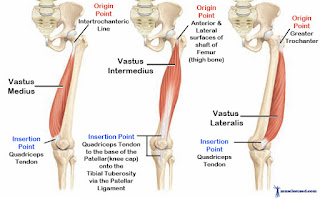QuadricepsThe Quadriceps Femurs which derives it's name from the Latin, meaning four headed muscle of the femur can be subdivided into four muscles or heads. These are the Vastus Intermedius, the Vastus Lateralis, the Vastus medialis and the Rectus Femoris. This group of muscles combined are the largest muscles of the leg and located on the posterior of the femur. They are more commonly know as the Quadriceps, Quadriceps Extensors or in short as the Quads. The Vastus Intermedius, Lateralis and Medialis are three quarters of the group of muscles which make up the quadriceps. They appear to be just one muscle surrounding a large superficial aponeurosis on the posterior of the femur but are in fact three different muscles (heads) with three different points of attachment.  The Quadricep Muscles comprise of 4 muscles the Vactus Lateralis, Vactus Medialis, Vactus Intermedius and the Rectus Femoris
All four Quadricep muscles powerfully combine working in tandem primarily as extensors of the knee joint. They are extremely crucial muscles aiding in important actions such as walking, running, jumping and squatting in addition to stabilizing the patella. The Rectus Femoris has additional responsibilities which is a result of being attached to the ilium and that is to assist as a flexor of the hip (bending the thigh). The Sartorius muscles are not in fact part of the Quadriceps but work closely with them and is responsible for some crucial movements in the leg. They are the longest single muscles in the human body. Primary they are responsible for assisting to flex the knee and the thigh, helping to abduct(move the leg outwards) and in outward rotation, assist to cross one leg over the other , as well as help us to climb stairs and as a smaller role in walking. The Satorius muscles also has the responsibility to hold all the muscles beneath it in place. The origin attachment point of the Satorius muscle is from the tip of the anterior superior iliac spine and it's insertion attachment points are at the medial side of the knee joint as well as the capsule of the knee joint and the upper, medial side of the tibia. Leave a Reply | ||
Copyright © 2016 Muscles Used - All Rights Reserved  | ||
QuadricepsThe Quadriceps Femurs which derives it's name from the Latin, meaning four headed muscle of the femur can be subdivided into four muscles or heads. These are the Vastus Intermedius, the Vastus Lateralis, the Vastus medialis and the Rectus Femoris. This group of muscles combined are the largest muscles of the leg and located on the posterior of the femur. They are more commonly know as the Quadriceps, Quadriceps Extensors or in short as the Quads. The Vastus Intermedius, Lateralis and Medialis are three quarters of the group of muscles which make up the quadriceps. They appear to be just one muscle surrounding a large superficial aponeurosis on the posterior of the femur but are in fact three different muscles (heads) with three different points of attachment.  The Quadricep Muscles comprise of 4 muscles the Vactus Lateralis, Vactus Medialis, Vactus Intermedius and the Rectus Femoris
All four Quadricep muscles powerfully combine working in tandem primarily as extensors of the knee joint. They are extremely crucial muscles aiding in important actions such as walking, running, jumping and squatting in addition to stabilizing the patella. The Rectus Femoris has additional responsibilities which is a result of being attached to the ilium and that is to assist as a flexor of the hip (bending the thigh). The Sartorius muscles are not in fact part of the Quadriceps but work closely with them and is responsible for some crucial movements in the leg. They are the longest single muscles in the human body. Primary they are responsible for assisting to flex the knee and the thigh, helping to abduct(move the leg outwards) and in outward rotation, assist to cross one leg over the other , as well as help us to climb stairs and as a smaller role in walking. The Satorius muscles also has the responsibility to hold all the muscles beneath it in place. The origin attachment point of the Satorius muscle is from the tip of the anterior superior iliac spine and it's insertion attachment points are at the medial side of the knee joint as well as the capsule of the knee joint and the upper, medial side of the tibia. Leave a Reply | ||
Copyright © 2016 Muscles Used - All Rights Reserved  | ||






No comments:
Post a Comment